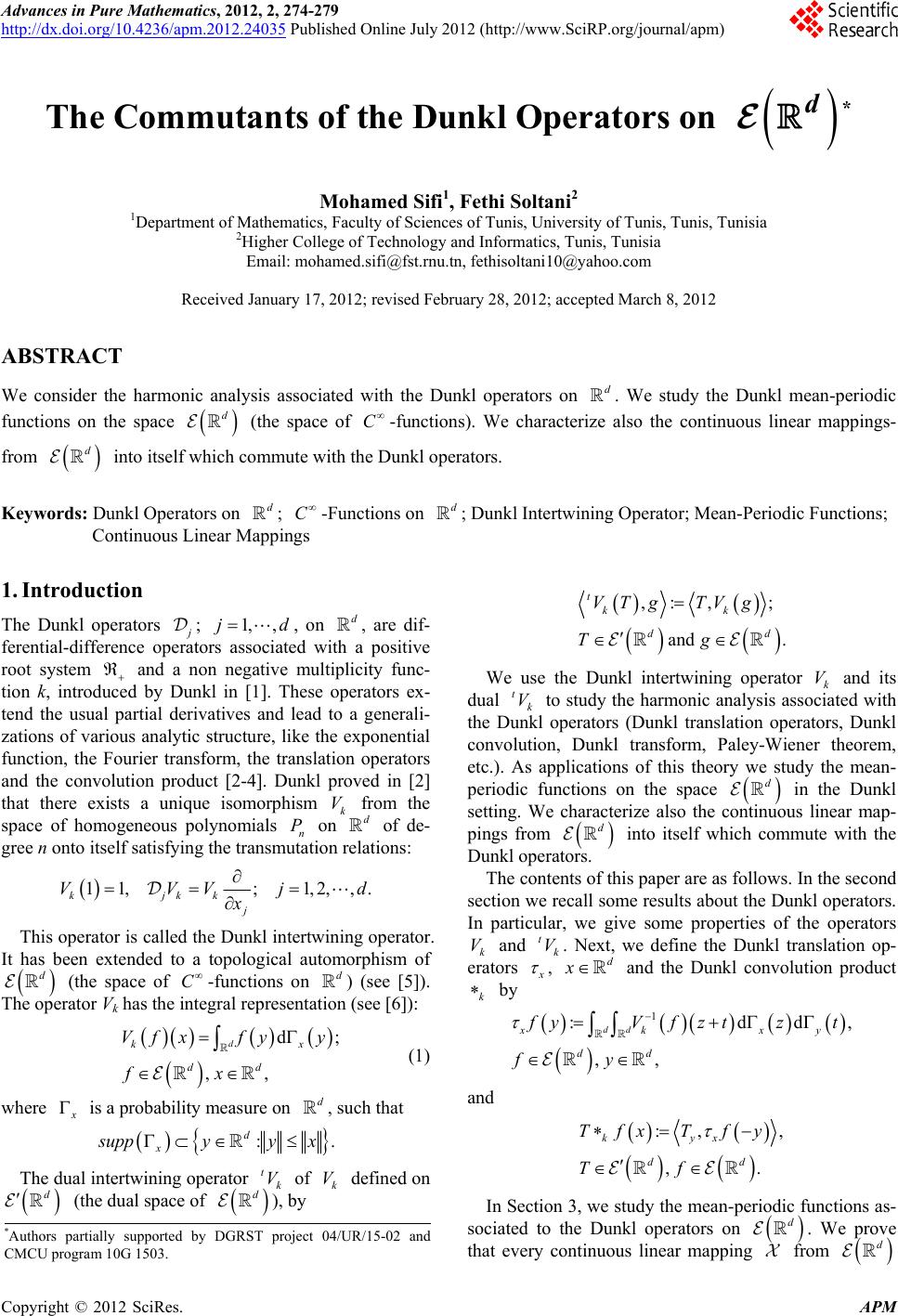 Advances in Pure Mathematics, 2012, 2, 274-279 http://dx.doi.org/10.4236/apm.2012.24035 Published Online July 2012 (http://www.SciRP.org/journal/apm) The Commutants of the Dunkl Operators on d d d C * Mohamed Sifi1, Fethi Soltani2 1Department of Mathematics, Faculty of Sciences of Tunis, University of Tunis, Tunis, Tunisia 2Higher College of Technology and Informati cs, Tunis, Tunisia Email: mohamed.sifi@fst.rnu.tn, fethisoltani10@yahoo.com Received January 17, 2012; revised Februa ry 28, 2012; accepted March 8, 2012 ABSTRACT We consider the harmonic analysis associated with the Dunkl operators on . We study the Dunkl mean-periodic functions on the space (the space of -functions). We characterize also the continuous linear mappings- from into itself which commu te with the Dunkl operators. d d Cd Keywords: Du nkl O perators on ; -Functions on ; Dunkl Intertwining Operator; Mean-Periodic Functions; Continuous Linear Mappings 1. Introduction ,: ,; and . tkk dd VT gTVg Tg tV d The Dunkl operators 1, ,jd; d Pd , on , are dif- ferential-difference operators associated with a positive root system and a non negative multiplicity func- tion k, introduced by Dunkl in [1]. These operators ex- tend the usual partial derivatives and lead to a generali- zations of various analytic structure, like the exponential function, the Fourier transform, the translation operators and the convolution product [2-4]. Dunkl proved in [2] that there exists a unique isomorphism k V from the space of homogeneous polynomials n on of de- gree n onto itself satisfying the transmutation relations: 11, ; kjkk j VVV x1,2,,.jd d Cd d; ,, kx dd Vfxfy y This operator is called the Dunkl intertwining operator. It has been extended to a topological automorphism of (the space of -functions on ) (see [5]). The operator Vk has the integral representation (see [6]): d fx (1) where is a probability measur e on , such that d :. d x uppy x tVk y The dual intertwining oper ator k of V defined on (the dual space of d We use the Dunkl intertwining operator k V and its dual k to study the harmonic analysis associated with the Dunkl operators (Dunkl translation operators, Dunkl convolution, Dunkl transform, Paley-Wiener theorem, etc.). As applications of this theory we study the mean- periodic functions on the space in the Dunkl setting. We characterize also the continuous linear map- pings from d V V into itself which commute with the Dunkl operators. The contents of this paper are as follows. In the second section we recall some results about the Dunkl operators. In particular, we give some properties of the operators k and tk. Next, we define the Dunkl translation op- erators , and the Dunkl convolution product d x k by 1 :dd, ,, dd xkxy dd yVfztzt fy and :, , ,. kyx dd TfxT fy Tf d d ), by In Section 3, we study the mean-periodic functions as- sociated to the Dunkl operators on . We prove that every continuous linear mapping from *Authors partially supported by DGRST project 04/UR/15-02 and CMCU program 10G 1503. d C opyright © 2012 SciRes. APM 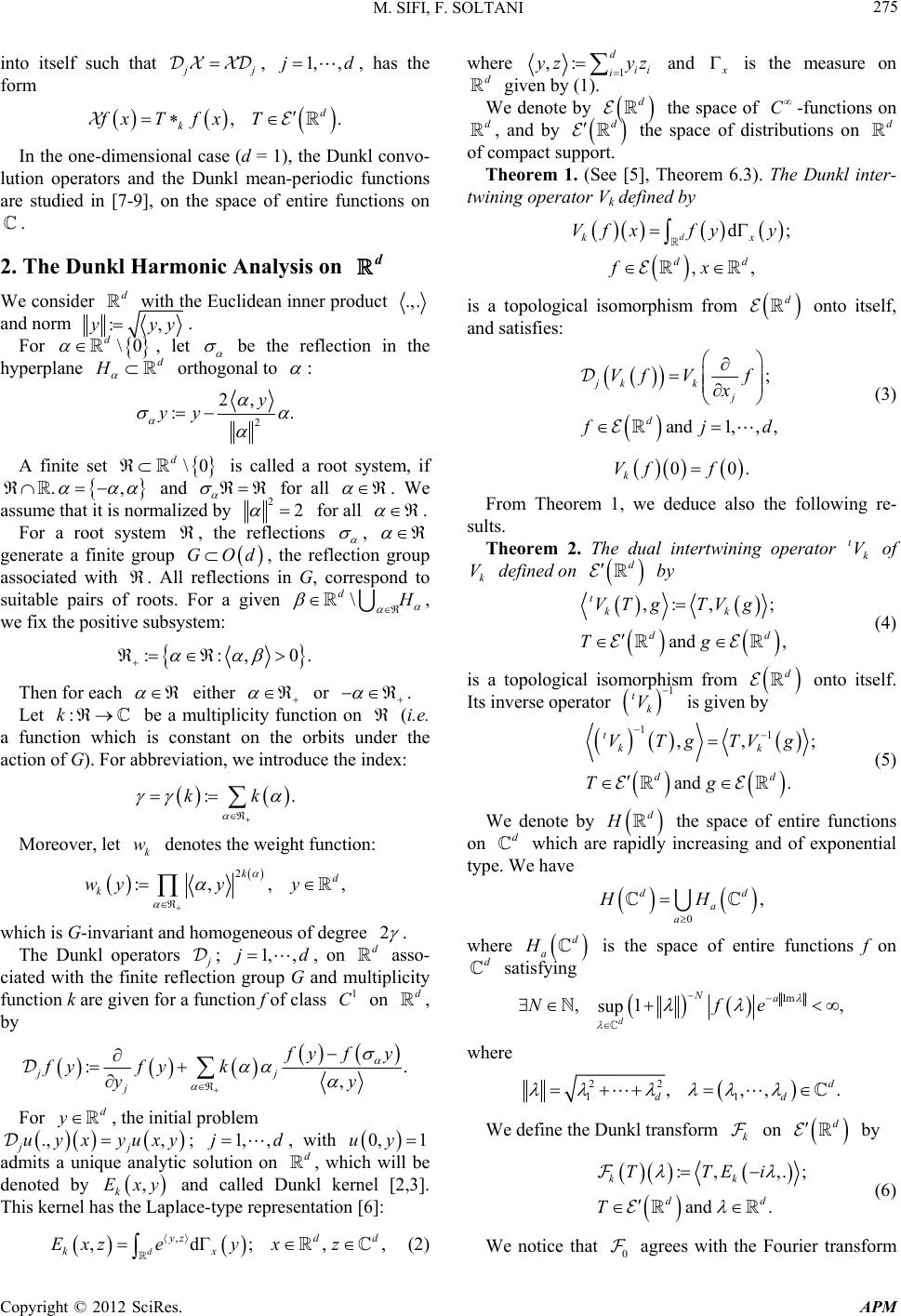 M. SIFI, F. SOLTANI 275 into itself such that j k T fx , , has the form 1, ,jd ,. d T d fx d In the one-dimensional case (d = 1), the Dunkl convo- lution operators and the Dunkl mean-periodic functions are studied in [7-9], on the space of entire functions on . 2. The Dunkl Harmonic Analysis on We consider with the Euclidean inner product .,. and norm :, yy \0 . For , let d be the reflection in the hyperplane orthogonal to d H : 2 2, :. y yy \0 d A finite set is called a root system, if . , and for all . We assume that it is normalized by 22 for all . For a root system , the reflections , generate a finite group dGO \ d , the reflection group associated with . All reflections in G, correspond to suitable pairs of roots. For a given , we fix the positive subsystem: ::,0. Then for each either or . Let be a multiplicity function on :k (i.e. a function which is constant on the orbits under the action of G). For abbreviation, we introduce the index: :.kk Moreover, let denotes the weight function: k w ,, d y 2 2 :, k k wy y which is G-invariant and homogeneous of degree . The Dunkl operators ; , on asso- ciated with the finite reflection group G and multiplicity function k are given for a function f of class on , by 1,,jd d 1 Cd :. , jj j yf y yy d y fy fy k For , the initial problem ; .,uy , jj x yuxy1, ,jd , with 0, 1uy admits a unique analytic solution on , which will be denoted by and called Dunkl kernel [2,3]. This kernel has the Laplace-type representation [6]: d , k Exy , ,d d where 1 i and ,: d ii yz yz d is the measure on given by (1). We denote by d d the space of C-functions on , and by d d the space of distributions on of compact support. Theorem 1. (See [5], Theorem 6.3). The Dunkl inter- twining operator Vk defined by d; ,, d kx dd Vfxfy y fx d is a topological isomorphism from onto itself, and satisfies: ; and1,, , jkk j d Vf Vf x ;,, zdd z kx Exzey x (2) jd (3) 00. k Vf f k V k V From Theorem 1, we deduce also the following re- sults. Theorem 2. The dual intertwining operator t of defined on d by ,: ,; and , tkk dd VT gTVg Tg d 1 tk V (4) is a topological isomorphism from onto itself. Its inverse operator is given by 11 ,, ; and . tkk dd VTgTVg Tg (5) We denote by d H d the space of entire functions on which are rapidly increasing and of exponential type. We have 0 , dd a a HH where d H d a is the space of entire functions f on satisfying Im ,1 , sup d Na Nfe where 22 11 ,,,. d dd k d by We define the Dunkl transform on :, ,.; and . kk dd TTEi T 0 (6) We notice that agrees with the Fourier transform Copyright © 2012 SciRes. APM 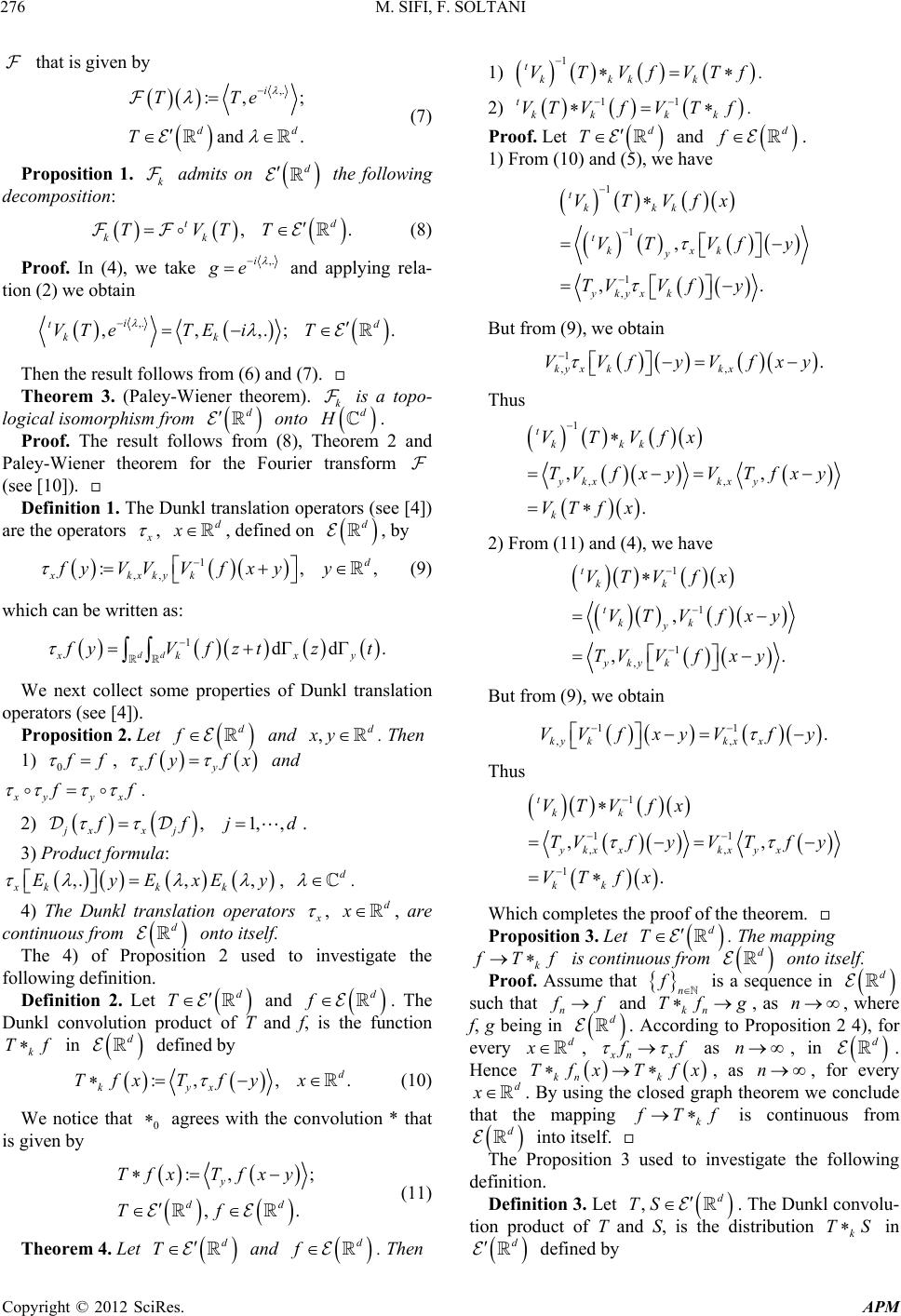 M. SIFI, F. SOLTANI 276 that is given by T ,. :, ; and . i dd TTe d ,. td TT (7) Proposition 1. admits on the following decomposition: k kk TV (8) Proof. In (4), we take ,.i ge and applying rela- tion (2) we obtain ,.; . td T k ,. ,, i kk VTeTE i Then the result follows from (6) and (7). Theorem 3. (Paley-Wiener theorem). is a topo- logical isomorphism from d onto . d H Proof. The result follows from (8), Theorem 2 and Paley-Wiener theorem for the Fourier transform (see [10]). Definition 1. The Dunkl translation operators (see [4]) are the operators , , defined on , by d x d :,, d y y 1 ,,xkxkyk fyVVVf x (9) which can be written as: dd. xy z t f,d xy 1 dd xk fyVf zt We next collect some properties of Dunkl translation operators (see [4]). Proposition 2. Let and . Then d 1) 0ff , xy yfx and xy yx f . 2) jxxj,1,, fj d . 3) Product formula: ,y d ,. xk k Ey ,k ExE , . 4) The Dunkl translation operators , , are continuous from onto itself. d x d T d f The 4) of Proposition 2 used to investigate the following definition. Definition 2. Let and . The Dunkl convolution product of T and f, is the function in defined by d k Tf d :,, . d kyx TfxT fyx 0 (10) We notice that agrees with the convolution * that is given by Tfx Tf :, ; ,. y dd Tfxy T d f 1 tkkkk VTVfVTf (11) Theorem 4. Let and . Then d 1) . 11tkk kk VT VfVTf . 2) d T d f and . Proof. Let 1) From (10) and (5), we have 1 1 1 , , ,. tkkk tkxk y ykyx k VTVfx VTVf y TVV fy But from (9), we obtain 1 ,, . ky xkkx VVfyVfxy Thus 1 ,, ,, . tkkk ykxkx y k VTVfx TVfxyVT fxy VT fx 2) From (11) and (4), we have 1 1 1 , , ,. tkk tkk y yky k VTVfx VTV fxy TVVfx y But from (9), we obtain 11 ,, . kykkx x VVfxyVfy Thus 1 11 ,, 1 ,, . tkk ykx xkxyx kk VTV fx TVfyV Tfy VT fx d T Which completes the proof of the theorem. Proposition 3. Let . The mapping k Tf d is continuous from onto itself. n f is a sequence in Proof. Assume that d such that n fg and kn Tf n, as , where f, g being in d d xxn x . According to Proposition 2 4), for every , f n as , in d . Hence Tfx Tfx n d x k knk , as , for every . By using the closed graph theorem we conclude that the mapping Tf is continuous from d ,d TS k TS into itself. The Proposition 3 used to investigate the following definition. Definition 3. Let . The Dunkl convolu- tion product of T and S, is the distribution in d defined by Copyright © 2012 SciRes. APM 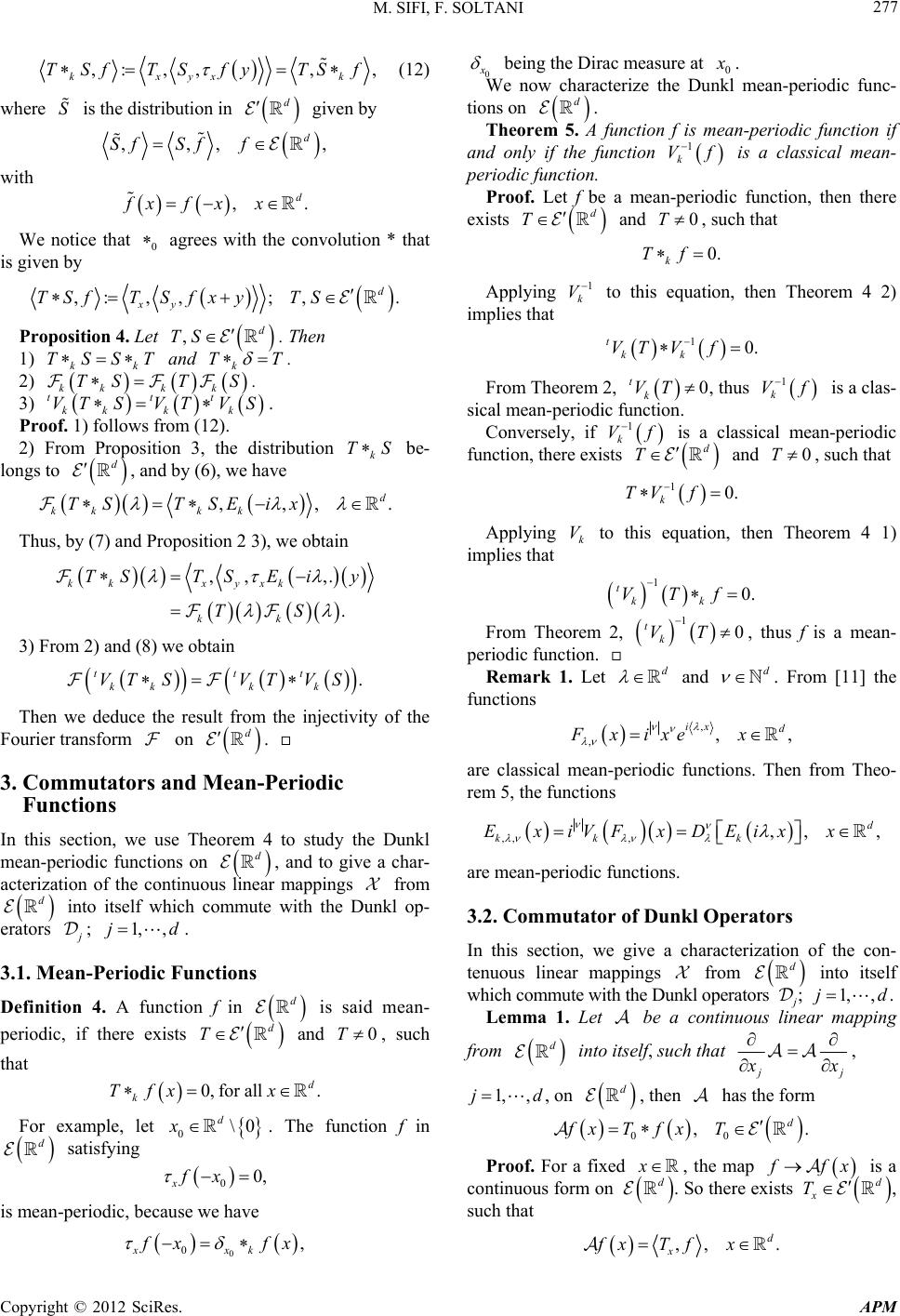 M. SIFI, F. SOLTANI 277 ,: ,, kxyx TSfTS fy , , k TSf S d (12) where is the distribution in given by , , d Sf f ,. d x x 0 ,,Sf with fx f We notice that agrees with the convolution * that is given by , . d S ,: ,,; xy TSfTSfxyT Proposition 4. Let ,d TS k . Then 1) and TT kk TSST . 2) k T S t T VS kS kk k TS. 3) . tt kk VT S k k Proof. 1) follows from (12 ) . V 2) From Proposition 3, the distribution T be- longs to , and by (6), we have d ,,Ei ,d kk kk TS TSx . Thus, by (7) and Proposition 2 3), we obtain ,, kk xy kk TS TS ,. . xk Ei y TS 3) From 2) and (8) we obtain . tt k k T VS t kk VT SV Then we deduce the result from the injectivity of the Fourier transform on d . 3. Commutators and Mean-Periodic Functions In this section, we use Theorem 4 to study the Dunkl mean-periodic functions on d d , and to give a char- acterization of the continuous linear mappings from into itself which commute with the Dunkl op- erators ; . 1,,jd 3.1. Mean-Periodic Functions Definition 4. A function f in is said mean- d d 0Tperiodic, if there exists T and , such that 0, f k Tfxor all. d x For example, let 0\0x d 00, xfx 0, xk d. The function f in satisfying is mean-periodic, because we have 0x xfx 0 being the Dirac measure at 0 . We now characterize the Dunkl mean-periodic func- tions on d 1 kf . Theorem 5. A function f is mean-periodic function if and only if the function V is a classical mean- periodic function. Proof. Let f be a mean-periodic function, then there exists d T 0T and , such that 0. k Tf 1 k V Applying to this equation, then Theorem 4 2) implies that 10. tkk VT Vf From Theorem 2, 0 tVT 1 k Vf k, thus is a clas- sical mean-periodic function. Conversely, if 1f d T 0 10. k TV f k V is a classical mean-periodic function, there exists and T, such that k V 10. tkk VTf 10 tk VT d d Applying to this equation, then Theorem 4 1) implies that From Theorem 2, , thus f is a mean- periodic fu n ction. Remark 1. Let and . From [11] the functions , ,,, ix d Fxixex are classical mean-periodic functions. Then from Theo- rem 5, the functions ,, ,,, , d kk k ExiVFxDEixx d are mean-periodic functions. 3.2. Commutator of Dunkl Operators In this section, we give a characterization of the con- tenuous linear mappings from into itself which commute with the Dunkl operators 1, ,jd ; . Lemma 1. Let be a continuous linear mapping d into itself, such that from j x 1, ,jd , d , then has the form , on 00 ,. d fxT fxT x Proof. For a fixed , the map fx is a continuous form o n d . So there exists d x T , such that ,, . d x fx Tfx Copyright © 2012 SciRes. APM 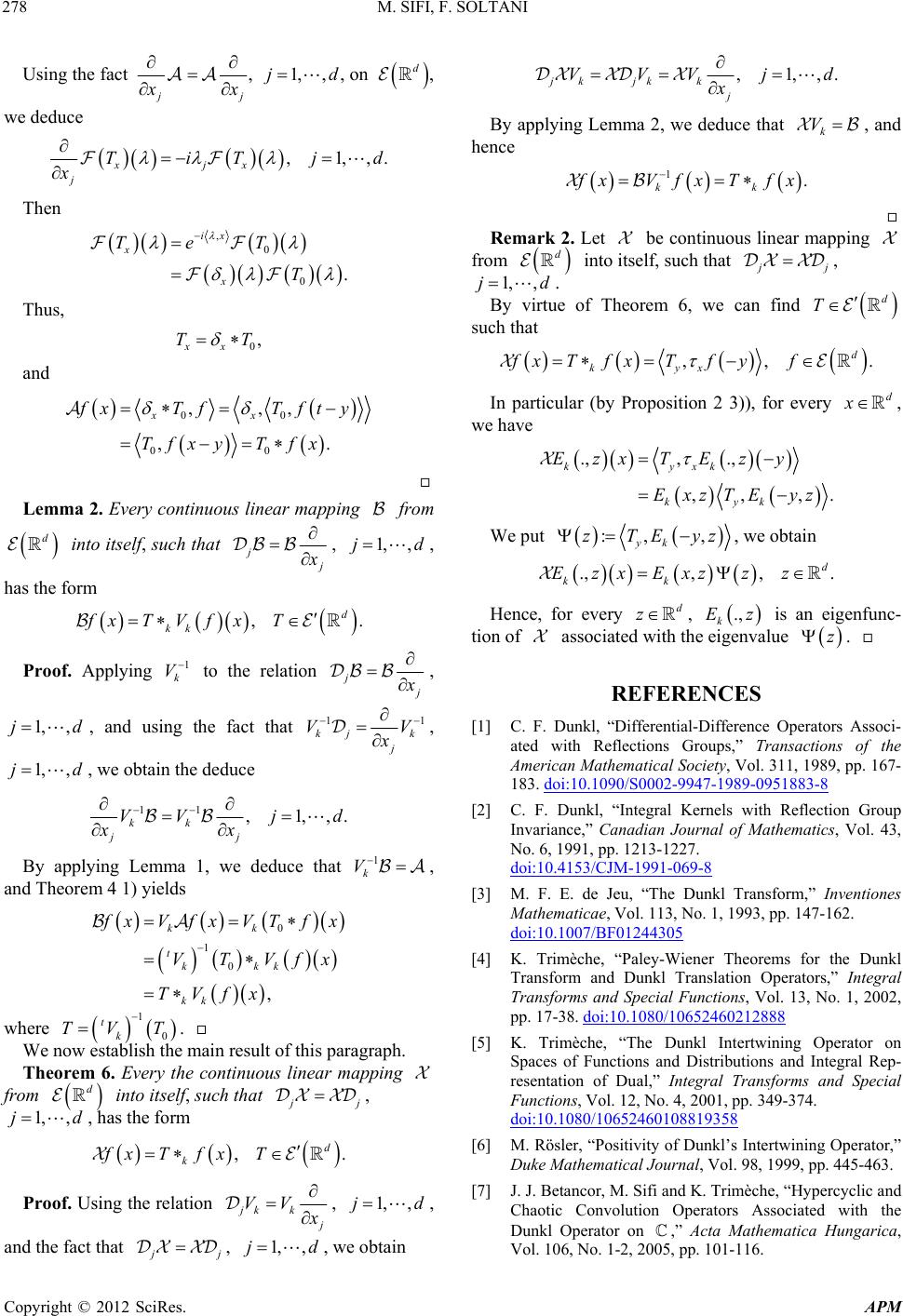 M. SIFI, F. SOLTANI 278 Using the fact j x jd, , on 1, , d , we deduce xjx j TiT x ,1,,.jd Then 0 0. T T ,ix x x Te 0, xx TT Thus, and 0 , ,. Tfty fx d 0 00 ,, xx fx Tf TfxyT Lemma 2. Every continuous linear mapping from into itself, such that j 1, , jd , , has the form kk fxTVfx ,. d T 1 k Proof. Applying V to the relation j , , and using the fact that 1, jd,11 kjk j V x V 1,jd , , we obtain the deduce , 11 kk jj VV xx ,1,,.jd 1 k By applying Lemma 1, we deduce that V 0 , kk kkk , and Theorem 4 1) yields 1 0 t kk xVfx VT TVf 1 t VTfx Vfx x TVT d where . 0 k We now establish the main result of this paragraph. Theorem 6. Every the continuous linear mapping from into itself, such that j 1, ,jd ,. d T , , has the form k fx Tfx Proof. Using the relation jk k VV 1, ,jd , , and the fact that j , , we obtain 1,,jd ,1,,. jkjk kj VVV jd x k V By applying Lemma 2, we deduce that , and hence 1. kk xVfxTfx Remark 2. Let be continuous linear mapping from d into itself, such that j 1, ,jd , . By virtue of Theorem 6, we can find d T such that ,, . d kyx fx TfxTfyf d x In particular (by Proposition 2 3)), for every , we have .,, ., ,, ,. kyxk kyk EzxTEzy ExzTEyz :, , yk zTEyz We put , we obtain .,, ,. d kk EzxExzz z d z Hence, for every .,Ez , k is an eigenfunc- tion of associated with the eigenvalue z. REFERENCES [1] C. F. Dunkl, “Differential-Difference Operators Associ- ated with Reflections Groups,” Transactions of the American Mathematical Society, Vol. 311, 1989, pp. 167- 183. doi:10.1090/S0002-9947-1989-0951883-8 [2] C. F. Dunkl, “Integral Kernels with Reflection Group Invariance,” Canadian Journal of Mathematics, Vol. 43, No. 6, 1991, pp. 1213-1227. doi:10.4153/CJM-1991-069-8 [3] M. F. E. de Jeu, “The Dunkl Transform,” Inventiones Mathematicae, Vol. 113, No. 1, 1993, pp. 147-162. doi:10.1007/BF01244305 [4] K. Trimèche, “Paley-Wiener Theorems for the Dunkl Transform and Dunkl Translation Operators,” Integral Transforms and Special Functions, Vol. 13, No. 1, 2002, pp. 17-38. doi:10.1080/10652460212888 [5] K. Trimèche, “The Dunkl Intertwining Operator on Spaces of Functions and Distributions and Integral Rep- resentation of Dual,” Integral Transforms and Special Functions, Vol. 12, No. 4, 2001, pp. 349-374. doi:10.1080/10652460108819358 [6] M. Rösler, “Positivity of Dunkl’s Intertwining Operator,” Duke Mathematical Journal, Vol. 98, 1999, pp. 445-463. [7] J. J. Betancor, M. Sifi and K. Trimèche, “Hypercyclic and Chaotic Convolution Operators Associated with the Dunkl Operator on ,” Acta Mathematica Hungarica, Vol. 106, No. 1-2, 2005, pp. 101-116. Copyright © 2012 SciRes. APM  M. SIFI, F. SOLTANI Copyright © 2012 SciRes. APM 279 doi:10.1007/s10474-005-0009-1 [8] J. J. Betancor, M. Sifi and K. Trimèche, “Intertwining Operator and the Commutators of the Dunkl Operator on ,” Mathematical Sciences Research Journal, Vol. 10, 2006, pp. 66-78. [9] N. B. Salem and S. Kallel, “Mean-Periodic Functions Associated with the Dunkl Operators,” Integral Trans- forms and Special Functions, Vol. 15, No. 2, 2004, pp. 155-179. doi:10.1080/10652460310001600735 [10] L. Hörmander, “Linear Partial Differential Operators,” Springer-Verlag, Berlin, Gottingen, Heidelberg, 1964. [11] L. Schwartz, “Théorie Générale des Fonctions Moyennes Périodiques,” Annals of Mathematics, Vol. 48, No. 4, 1947, pp. 857-929. doi:10.2307/1969386
|